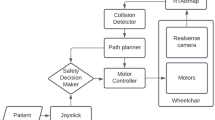Abstract
This paper presents the hardware and software control framework for a semi-auton omous wheelchair. The hardware design incorporates modular and reconfigurable sensors and corresponding low-level software architecture. Two control schemes are discussed. Assisted control that augments the user inputs by providing functionalities such as obstacle avoidance and wall following. And, semi-autonomous navigation which takes higher level destination goals and executes a simultaneous localization and mapping algorithm. We also propose an adaptive motion control with a online parameter estimation. The paper presents both experimental and simulation results.














Similar content being viewed by others
Explore related subjects
Discover the latest articles, news and stories from top researchers in related subjects.References
Millan JR, Rupp R, Muller-Putz GR, Murray-Smith R, Giugliemma C, Tangermann M, Vidaurre C, Cincotti F, Kübler A, Leeb R, Neuper C, Müller K-R, Mattia D (2010) Combining brain-computer interfaces and assistive technologies: state-of-the-art and challenges. Front Neurosci 4:161. doi:10.3389/fnins.2010.00161
Simpson RC (July 2005) Smart wheelchairs: a literature review. J Rehabil Res Dev 42(4):423–438
Kulyukin V, Gharpure C, Nicholson J (2005) Robocart: toward robot-assisted navigation of grocery stores by the visually impaired. In: Intelligent Robots and Systems, (IROS 2005), 2005 IEEE/RSJ International Conference on, pp. 2845–2850
Tsui KM, Feil-Seifer DJ, Mataric MJ, Yanco HA (2009) Performance evaluation methods for assistive robotic technology. In: Madhavan R, Tunstel E, Messina E (eds) Performance evaluation and benchmarking of intelligent systems. Springer, US, pp 41–66
Krebs HI (2003) Rehabilitation robotics: performance-based progressive robot-assisted therapy. Auton Robots 15:720
Tsui KM, Yanco HA, Feil-Seifer DJ, Mataric MJ (2008) Survey of domain-specific performance measures in assistive robotic technology. In: Proceedings of the 8th workshop on performance metrics for intelligent systems, PerMIS’08, ACM, New York, NY, USA, pp. 116–123
Buhler Ch, Hoelper R, Hoyer H, Humann W (1995) Autonomous robot technology for advanced wheelchair and robotic aids for people with disabilities. Rob Auton Syst 14(2–3):213–222
Alqasemi R, Dubey R (2009) Kinematics, control and redundancy resolution of a 9-dof wheelchair-mounted robotic arm system for ADL tasks. In: Mechatronics and its applications, 2009. ISMA 09. 6th International Symposium on, pp. 1–7
Yanco H (1998) Wheelesley: a robotic wheelchair system: indoor navigation and user interface. In: Mittal V, Yanco H, Aronis J, Simpson R (eds) Assistive Technology and Artificial Intelligence, vol 1458, Lecture Notes in Computer Science. Springer, Berlin / Heidelberg, pp 256–268
Parikh SP, Grassi V Jr, Kumar V, Jr JO (2007) Integrating human inputs with autonomous behaviours on an intelligent wheelchair platform. Intell Syst IEEE 22(2):33–41
Perrin X, Chavarriaga R, Colas F, Siegwart R, Millan JR (2010) Brain-coupled interaction for semi-autonomous navigation of an assistive robot. Rob Auton Syst 58(12):1246–1255. Intelligent Robotics and Neuroscience
Iturrate I, Antelis JM, Kubler A, Minguez J (June 2009) A noninvasive brain-actuated wheelchair based on a P300 neurophysiological protocol and automated navigation. Rob IEEE Trans 25(3):614–627
Kossiakoff A, Sweet WN, Seymour SJ, Biemer SM (2003) Systems engineering: principles and practice, 2nd edn. Wiley, London
Palacin J, Valganon I, Pernia R (2006) The optical mouse for indoor mobile robot odometry measurement. Sens Actuators A Phys 126(1):141–147
Nistr D, Naroditsky O, Bergen J (2004) “Visual odometry”, in Computer Vision and Pattern Recognition, 2004. CVPR 2004. In: Proceedings of the 2004 IEEE computer society conference on, vol. 1, p. I652
Quigley M, Gerkey B, Conley K, Faust J, Foote T, Leibs J, Berger E, Wheeler R, Ng A (2009) ROS: an open-source Robot Operating System. In: ICRA workshop on open source software, vol. 3
Nezamfar H, Sinyukov D, Orhan U, Erdogmus D, Padir T (2013) Rain interface to control a tele-operated robot. In: Proceedings of the fifth international brain-computer interface meeting, June 2013
Kohlbrecher S, von Stryk O, Meyer J, Klingauf U (2011) A flexible and scalable SLAM system with full 3D motion estimation. In: 2011 IEEE international symposium on safety, security, and rescue robotics (SSRR), pp 155–160
Dijkstra EW (1959) A note on two problems in connexion with graphs. Numerische mathematik 1(1):269–271
von Hundelshausen F, Himmelsbach M, Hecker F, Mueller A, Wuensche HJ (2008) Driving with tentacles: integral structures for sensing and motion. J Field Rob 25(9):640–673
Astrom KJ, Wittenmark B (1994) Adaptive control. Addison-Wesley Longman Publishing Co., Inc., Boston, MA
Johnson BW, Aylor JH (1985) Dynamic modeling of an electric wheelchair. IEEE Trans Ind Appl IA–21(5):1284–1293
Acknowledgments
This material is based upon work supported by the National Science Foundation under Grant No. 1135854.
Author information
Authors and Affiliations
Corresponding author
Rights and permissions
About this article
Cite this article
Sinyukov, D., Desmond, R., Dickerman, M. et al. Multi-modal control framework for a semi-autonomous wheelchair using modular sensor designs. Intel Serv Robotics 7, 145–155 (2014). https://doi.org/10.1007/s11370-014-0149-7
Received:
Accepted:
Published:
Issue Date:
DOI: https://doi.org/10.1007/s11370-014-0149-7




